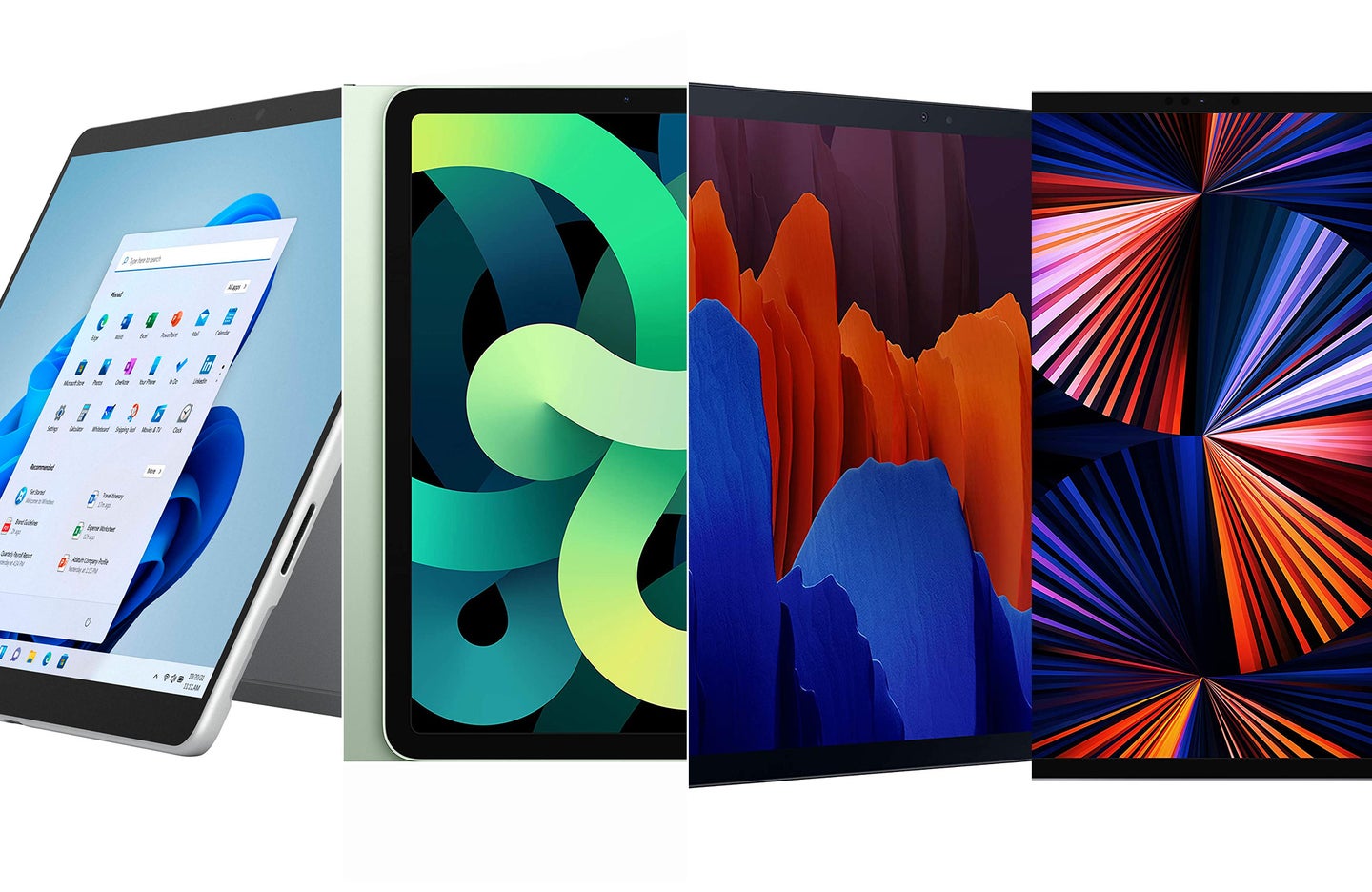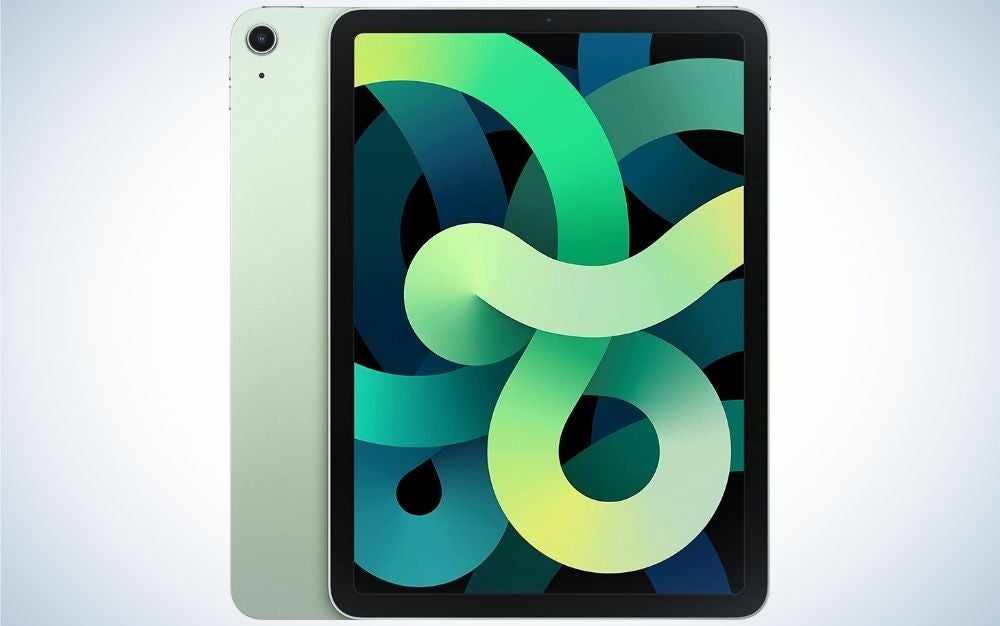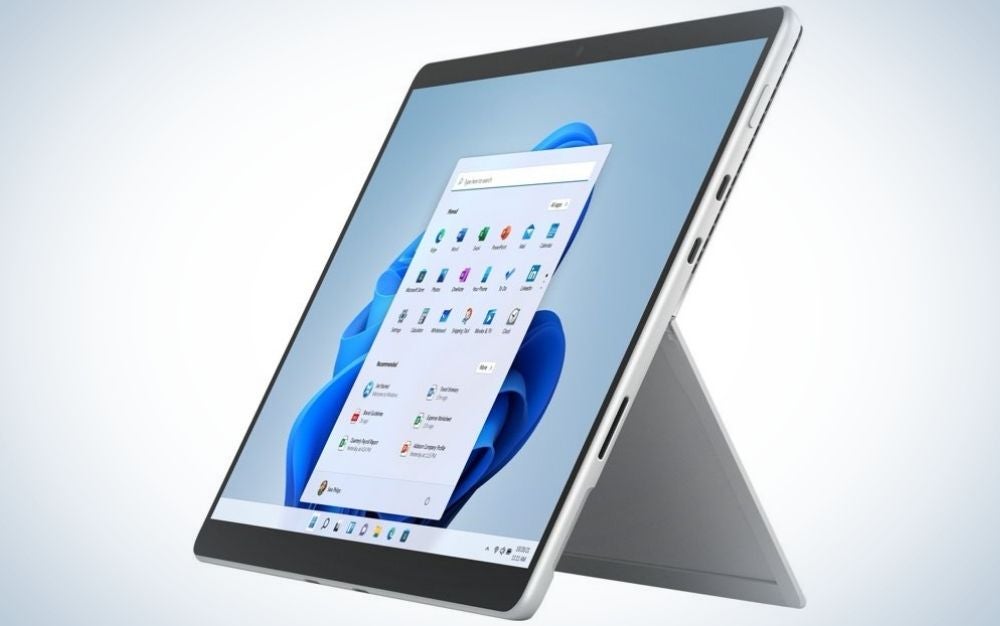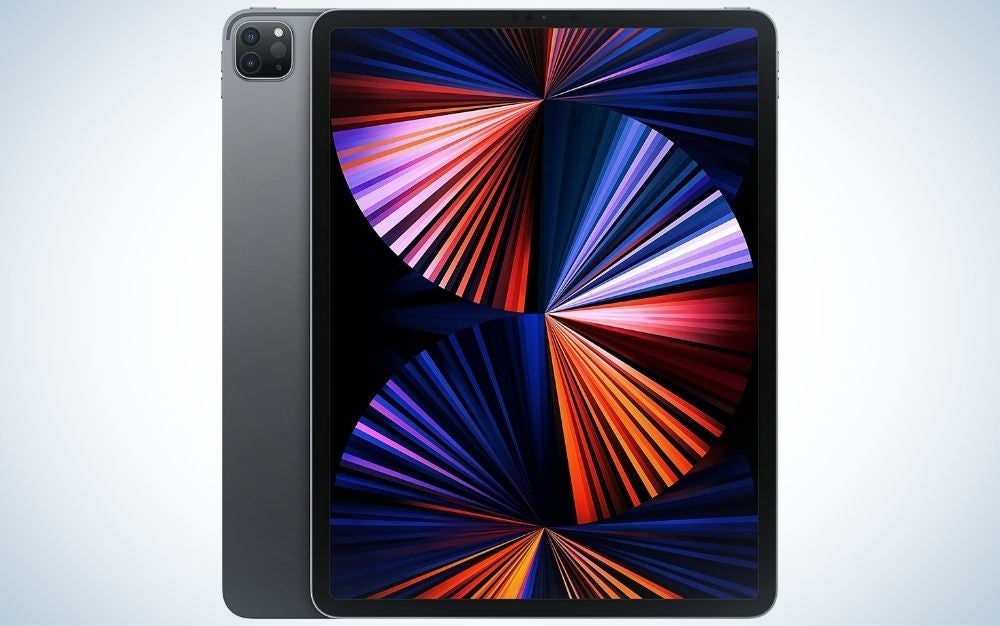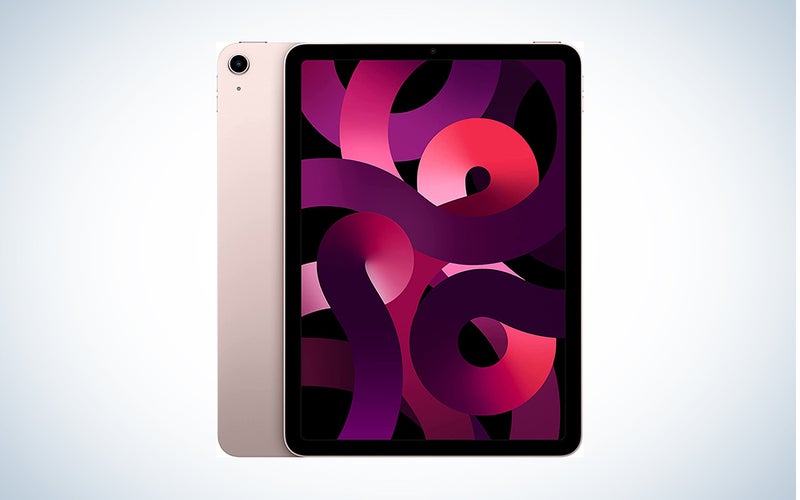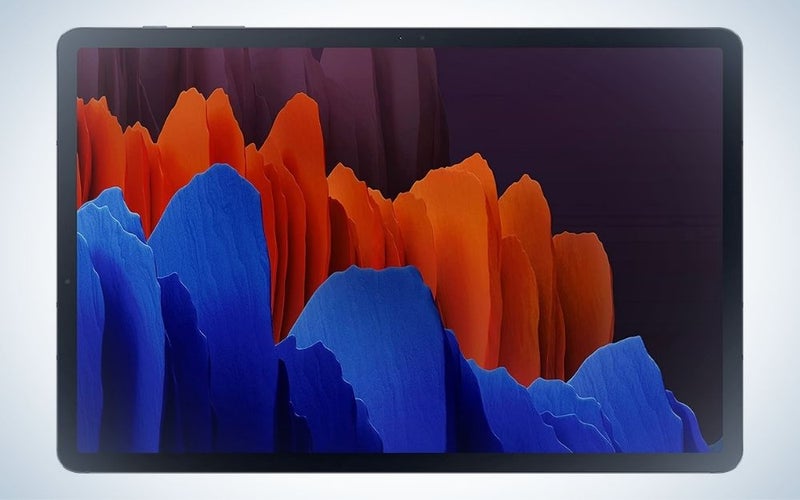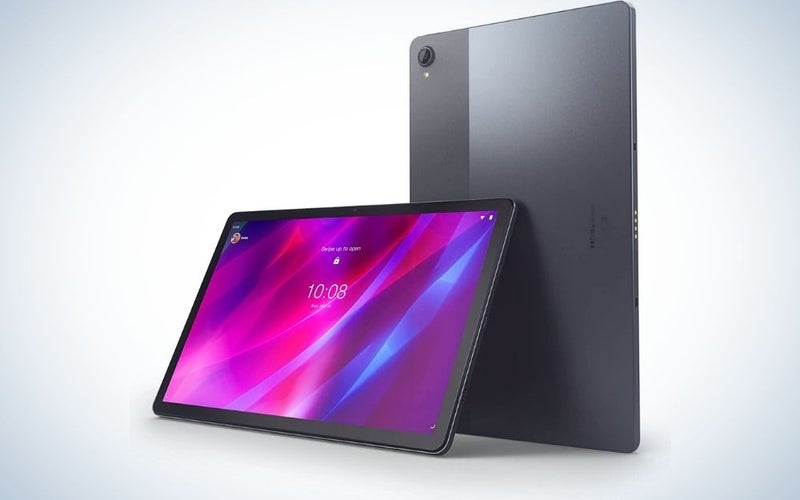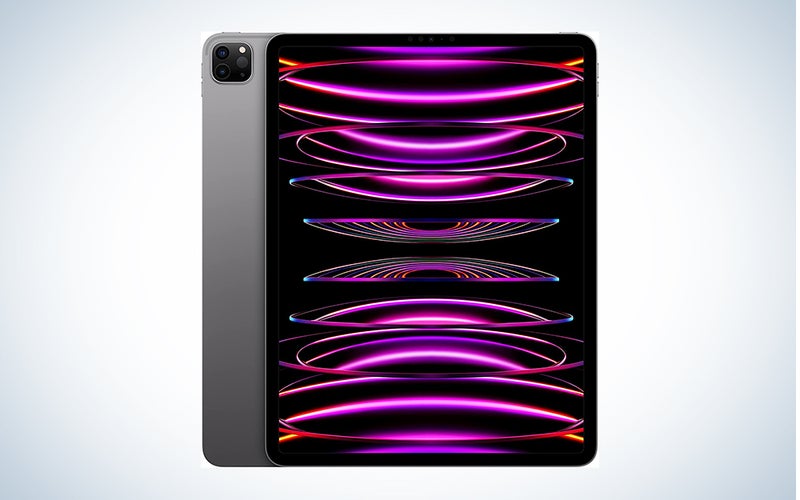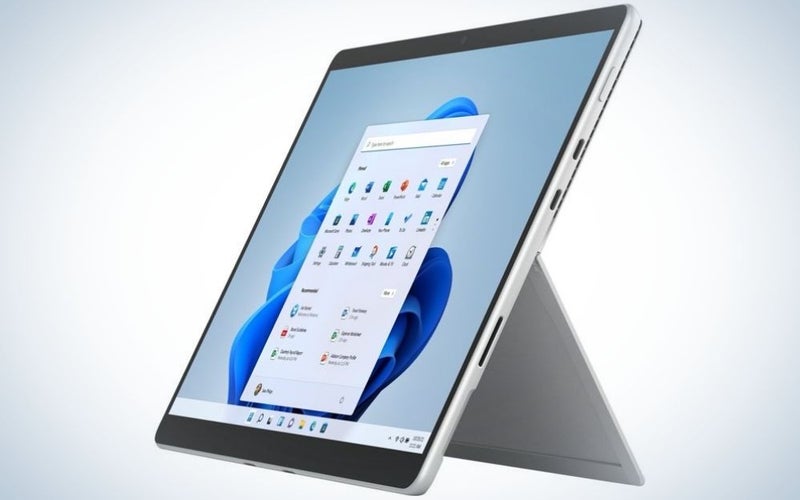There are so many models available, and typically each new tablet that enters the market comes with a larger, more powerful feature set than its predecessor. You’ll also find them at many different price points. For example, you can buy a basic tablet for under $100 or a high-end model that costs more than $2,000, which can make choosing tricky. Finding the best tablet comes down to how you want to use your tablet. For instance, if you intend to use your tablet for checking email or watching videos, you will have very different technology needs than a photographer editing photo or video content. In some cases, today’s top-of-the-line tablets can include laptop-like capabilities, something that not all users need. High-end machines can handle very complex photo editing as well as some compositing tasks. This type of work can use a lot of a device’s resources and require a powerful processor, which can bring up the price significantly.
- Best overall: Apple iPad Air (5th generation)
- Best for Android: Samsung Galaxy Tab S7 Plus
- Best budget: Lenovo Tab P11 Plus
- Best iPad for photo editing: Apple iPad Pro 12.9 inch (6th generation)
- Best Android for photo editing: Microsoft Surface Pro 8
How we picked the best tablets
We picked current models from the major brands that produce tablets for our list of best tablets and relied on a mixture of research and hands-on testing to pick the top performers in each category. To choose the best models, we considered many different factors but focused on those most important to consumers and creatives, especially photographers, including price, performance, the quality of the display, versatility, and its feature set. We also considered how portable the tablet is.
The best tablets: Reviews & Recommendations
Best overall: Apple iPad Air (5th generation)
Apple
Why it made the cut: New features like an updated design and a more powerful A14 Bionic processor allow this tablet to stand out from the pack, even in a competitive market making it the best tablet overall.
Key features
- Screen size: 10.9 inches
- Resolution: 2360 x 1640
- Weight: 1 pound
- Dimensions: 9.74 x 7.02 x 0.24 inches
- Operating System: iPadOS
Pros
- Includes a USB-C connection, for connecting extra storage
- Excellent performance
- Beautifully designed
- Ideal for basic and advanced tasks, including video and multimedia
Cons
- Lacks 3.5mm audio ports
- Lacks SD or microSD card slot
- Pen and keyboard sold separately
Apple didn’t drastically overhaul the iPad Air’s insides with its latest update, but the design changed a lot. It now looks like a more compact version of the flagship iPad Pro. While it’s not quite as powerful as its pricier sibling, it offers the right mix of design, power, and portability to suit most people. The new Air now has a powerful M1 chipset, so it’s capable of performing many different types of power-hungry tasks including photo and video editing.
In terms of design, Apple borrowed several elements from its top-of-the-line iPad, the iPad Pro, including its USB-C port, which allows you to attach an external SSD for expanding the amount of storage you have. That means you’re not stuck with the 64GB or 256GB of onboard storage.You can even plug a camera directly into the iPad to transfer images to its built-in storage.
Its screen is slightly less reflective than previous iPads, making for more pleasant viewing. And it has better sound, with four speakers– two at the top and two at the bottom–for a better audio experience. However, it still lacks a 3.5mm audio jack, which for some audiophiles is very important. Nevertheless, it’s a very powerful iPad that will meet the needs of most photographers, content creators, and consumers. Unfortunately, it doesn’t come with either a stylus pen or keyboard.
Best for Android: Samsung Galaxy Tab S7 Plus
Samsung Electronics
Why it made the cut: As the best Android tablet is concerned this model comes close to the performance you get on the top-performing Apple iPad.
Key features
- Screen size: 12.4 inches
- Resolution: 2800 x 1752
- Weight: 1.3 pounds
- Dimensions: 11.22 x 7.28 x 0.22 inches
- Operating System: Android
Pros
- Sharp, colorful 12.4-inch Super AMOLED display
- Up to 14 hours of battery life
- 120Hz refresh rate for smoothing video
- Newly redesigned and very responsive S pen stylus
- MicroSD slot to expand storage (up to 1TB)
Cons
- A bit pricey
Although this tablet is a bit on the pricey side, it’s an excellent performer and is powerful enough to handle all your work and personal tasks. It has a sharp, colorful 12.4-inch Super AMOLED display, which Samsung says is more flexible and has a better viewing experience than OLED. It also has a 120Hz refresh rate, which makes for smoother video. Lastly, it includes a new, redesigned, more responsive S Pen stylus.
The Tab S7+ has excellent battery life–the specs claim up to 14 hours of battery life when watching videos. And it’s available in 3 storage capacities: 128GB, 256GB, and 512GB.
How does it stand apart from Apple? In at least two important ways: First, it has a memory card slot, which allows you to expand your storage capacity by up to 1TB. And Samsung includes the S Pen stylus. That’s a critical element that Apple should note since they charge quite a bit extra for buying the Apple Pencil or Apple Pencil 2. Samsung recently announced new versions of the S-series tablets, and we’re looking forward to testing them when they hit the market.
Best budget: Lenovo Tab P11 Plus
Lenovo
Why it made the cut: This compact version of Apple’s iPad pairs portability with performance, which is great if you’re always on the go.
Key features
- Screen size: 11 inches
- Resolution: 2,000 x 1,200
- Weight: 1.1 pounds
- Dimensions: 10.2″ x 6.4″ x 0.295″
- Operating System: Android
Pros
- Affordable
- Up to 12 hours of video playback
- Dolby Atmos sound for watching content
Cons
- Not super powerful
- Unpredictable Android updates
When it comes to the best cheap tablet, Amazon’s Fire tablets tend to pop to the front of mind. While very affordable, they lack the flexibility of a more open operating system and they’re typically very underpowered. Lenovo’s budget-friendly Tab P11 employs a fairly powerful eight-core processor and up to 6GB RAM, which is more than enough for most tasks.
The 11-inch screen only has a 2,000 x 1,200 resolution, which isn’t as pixel dense as some of its competition, but again, it’s plenty for most tasks. It’s especially good for watching content since it can handle 1080p HD movies just fine and they don’t take up as much space as 4K versions. It even has a MicroSD slot built in for expanded storage and uploading photos and video, something many of its more expensive competition lacks.
Best iPad for photo editing: iPad Pro 12.9 inch (6th generation)
Apple
Why it made the cut: It’s very pricey, but this iPad Pro fits the bill for those looking for photo editing performance that can match a laptop.
Key features
- Screen size: 12.9 inches
- Resolution: 2732 x 2048
- Weight: 1.5 pounds
- Dimensions: 11.04 x 8.46 x 0.25 inches
- Operating System: iPadOS
Pros
- Superb performance and feature set
- Can be configured to have up to 2TB
- Beautiful display
- Excellent speakers produce superior-sounding audio
Cons
- Lacks 3.5mm audio ports and SD or microSD card slot
- Very expensive
- Pen and keyboard sold separately
This iPad is ideal for all types of content creators, including photographers, videographers, motion graphic designers, animators, and musicians. It not only has the best processors that allow you to create resource-intensive videos and multimedia, but it also packages it all in a very easy-to-use design. Plus, it gives you the ability to store those videos and presentations because the iPad Pro is available in several storage configurations, including 128GB, 256GB, 512GB, 1TB, and 2TB. Of course, it also includes a USB-C port to transfer media to an external SSD for additional storage.
But what prevents this iPad from being one of the best tablets for everyone is its very high sticker price, even for the basic version that’s Wi-Fi only and has just 128GB of storage. If you want one that includes a cellular data plan or more storage, it will cost even more. And as usual, if you want the Apple stylus pencil or a keyboard, you’ll need to pay still more. It’s one of the few drawbacks to this iPad, though. It can truly replace a full-powered laptop for some users who don’t need access to desktop versions of software.
Best Android for photo editing: Microsoft Surface Pro 8
Microsoft
Why it made the cut: The Surface Pro 8 runs using a full computer OS, Microsoft 11, which allows it to run full software versions, like Photoshop, instead of apps.
Key features
- Screen size: 13 inches
- Resolution: 2880 x 1920
- Weight: 1.96 pounds
- Dimensions: 11.3 in x 8.2 in x 0.37 inches
- Operating System: Windows
Pros
- Comes with Windows 11, so you can run full versions of software
- Very nicely designed
- Fast processor
- Refresh rate up to 120Hz
- Excellent front and rear-facing cameras
Cons
- Expensive
- Pen and keyboard sold separately
Although it’s quite pricey, there’s a lot to love about this powerful 2-in-1 laptop. It can be used as a laptop or reconfigured to perform like a tablet. Overall, the system is fast and performs very well. But what really makes this model stand out for content creators is that you can use a full version of your favorite software since it runs Windows 11 for its OS, not Android. So instead of using mobile apps, you can use the entire host of features and tools found in desktop versions of Photoshop, Lightroom, Premiere Pro, After Effects, and even Microsoft Word, Excel, etc.
A few things would make this product even better, mainly dropping the price a bit. It should also include the stylus pen and keyboard. But for those who want to stick with Windows and not buy an iPad Pro for their creative work, this model absolutely does the job.
What to consider when buying the best tablets for your needs
It’s easy to lust after the biggest and most powerful tablets, but that’s a good way to spend more money than you need on a device that’s overkill for your work and life.
To find the right model for you, figure out how much money you want to spend, and then dig into the specs. Here are some essential things to consider when you’re looking for the best tablets for you.
Platform
First, choose the operating system of your tablet. Apple iPads will use Apple’s iPadOS, which is stable and easy to use, although it doesn’t allow for as much customization as Android or Windows systems. Because it’s in the Apple ecosystem, the iPad is a very natural choice if you’re already using other Apple gear like a MacBook and iPhone.
If you choose to go with an Android tablet, in many cases, you’ll have the ability to do more customizing and expand your system. But it’s not always easy to use or as seamless when it comes to integrating with other devices.
iPadOS and Android aren’t the only two choices. If you buy the Microsoft Surface device, you’ll get Windows 11, a full computer operating system. A computer OS allows you to run full software versions instead of tablet-specific apps.
Size and portability
Another factor is to determine the size of the tablet. Models with smaller screens cost less and are more portable but often have fewer features. Larger models are pricer and more challenging to travel with but include premium capabilities. Most tablets come in one of two size ranges: Tablets that roughly measure between 7 and 8.5 inches in size and ones between 10 and 13 inches. Samsung recently introduced a new Galaxy tablet that checks in at a massive 15.6 inches.
Connectivity and storage
Tablets connect to other devices and networks via Wi-Fi, cellular networks. Most of the models we recommend are Wi-Fi only since you’ll pay more for a cellular connection. If you’re planning to spend a lot of time away from reliable WiFi, a mobile connection could be worth your while, but sometimes a phone acting as a hot spot can provide a connection that’s just fine for your needs.
The vast majority of the tablets you’ll find on the market at the moment connect to chargers and computers via USB-C. Even Apple has transitioned its iPads to USB-C connections instead of its proprietary Lightning cables.
Display quality
Most consumers will want to get the sharpest and most accurate display on their tablet. So, look for a high pixel density, which refers to the pixels per inch or ppi. A higher pixel density will have more tightly packed pixels on the display. The higher the number–most are between 175 and 350 ppi–the sharper the display. High-end options like the iPad Pro also offer high refresh rates, which means they refresh more times every second to make on-screen motion appear smoother. Apple calls this TrueMotion, but others will tell you in terms of hertz. A screen with 120Hz will refresh twice as often as one with a 60Hz refresh rate.
Battery life
Consider how much battery life you’ll need and how often you’ll have access to outlets for charging up. Many models have a battery life of 10 hours or more, depending on usage. Bigger tablets tend to offer more battery life at the cost of more bulk.
Audio ports
A wired connection is vital for sound quality with some audio files. Unfortunately, Apple has phased out 3.5mm jacks on most of its newer models. So, you’ll have to use wireless earphones or connect via that USB-C port with an adapter.
Cameras
Nearly all tablets today come with front and rear-facing cameras. However, since most people don’t shoot many photos or videos using a tablet, they’re not the most important feature you’ll need to consider unless you have a specific reason for it. For instance, the higher-end iPads can achieve some truly cool augmented reality feats using their rear cameras.
Nevertheless, if you plan to use your tablet for video conferencing and video chats, you’ll want to look closely at what’s available. Most front and rear-facing cameras range between 8 and 12 megapixels. Though a few models have cameras with very low megapixel counts that you may want to avoid if quality is important to you.
Accessories
Another important consideration is finding compatible accessories for your tablet, such as a keyboard, stylus, case, mount, earbuds, etc. Be sure to do some research to find the best accessories for your tablet. Also, check to see if your tablet comes with any important accessories. Some of these accessories can be extremely pricey, so make sure you consider the total cost of the package before you pull the trigger on the device itself.
FAQs
Q: What are tablets used for?
When tablets were first introduced more than ten years ago, many used them to mostly read text and ebooks, browse the web, and check emails.
Today, however, tablets are often very full-featured and rival the capabilities of some laptop computers. In fact, many tablets can produce many forms of multimedia. For example, you can download a variety of mobile apps for tasks like photo and video editing, creating music and audio, and producing various types of animation and motion graphics for movies and presentations.
Q: What’s a 2-in-1 laptop, and how is it a tablet?
A 2-in-1 laptop refers to a type of laptop computer that you can configure to look and behave like a traditional tablet. So, it has two operating modes–a laptop and a tablet.
A final word on the best tablets
It’s wise to consider which mobile apps you’ll want to use on your new iPad or Android tablet, particularly if you’re interested in making photo or video edits, or you want to create content for social media. And just as hardware changes are making tablets work better and faster, software and apps companies are designing software to work better.
Here are some suggested mobile apps to help you make the most of your tablet:
- For photo-editing apps: Try Adobe Lightroom, Snapseed, Prisma, VSCO, or PicsArt
- For video-editing apps: Try Adobe Premiere Rush, GoPro Quik, PowerDirector, KineMaster, VSCO, or iMovie (available for free, only on iPads)
- For creating multimedia for use on social media: Try Adobe Creative Cloud Express, which is available as both a web and mobile app, on both iPadOS and Android platforms.
